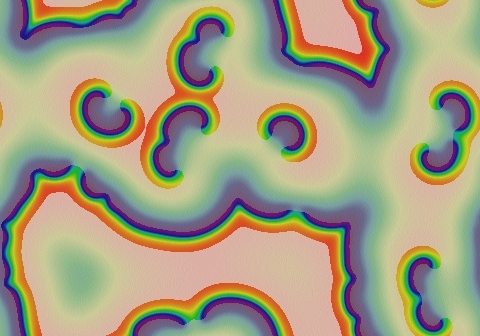Gray-Scott Model at F 0.0060, k 0.0390
These images and movie demonstrate the behavior of the Gray-Scott reaction-diffusion system with σ=Du/Dv=2 and parameters F=0.0060, k=0.0390.
Fairly smooth wavefronts, long-lasting spiral seeds. Close pairs of spiral seeds tend to annihilate, however, irregularities in the wavefronts sometimes cause new seeds to form (this can be seen several times throughout the movie). In large enough domains, the new seeds tend to outnumber those that annihilate, allowing a pattern to remain viable indefinitely.
Categories: Pearson ξ; Wolfram 3 (glossary of terms)
 increase F increase F
 | |||
 decrease k  |


|
15 frames/sec.; each fr. is 19 iter. steps = 9.5 tu; 1801 fr. total (17,109 tu) |  increase k 
|

|


| ||

 |
In these images:
- Color indicates level of u, ranging from purple (lowest u values) through blue, aqua, green, yellow and pink/red (highest u values)
- Areas where u is increasing are lightened to a light pastel tone; where u is decreasing the color is vivid.
- In areas where u is changing by less than ±3×10-6 per tu, an intermediate pastel color is seen. This includes areas that are in steady state or equilibrium.
''tu'' is the dimensionless unit of time, and ''lu'' the dimensionless unit of length, implicit in the equations that define the reaction-diffusion model. The grids for these simulations use Δx=1/143 lu and Δt=1/2 tu; the system is 3.2 lu wide. The simulation meets itself at the edges (periodic boundary condition); all images tile seamlessly if used as wallpaper.
Go back to Gray-Scott pattern index
This page was written in the "embarrassingly readable" markup language RHTF, and was last updated on 2015 Nov 07.
 s.27
s.27